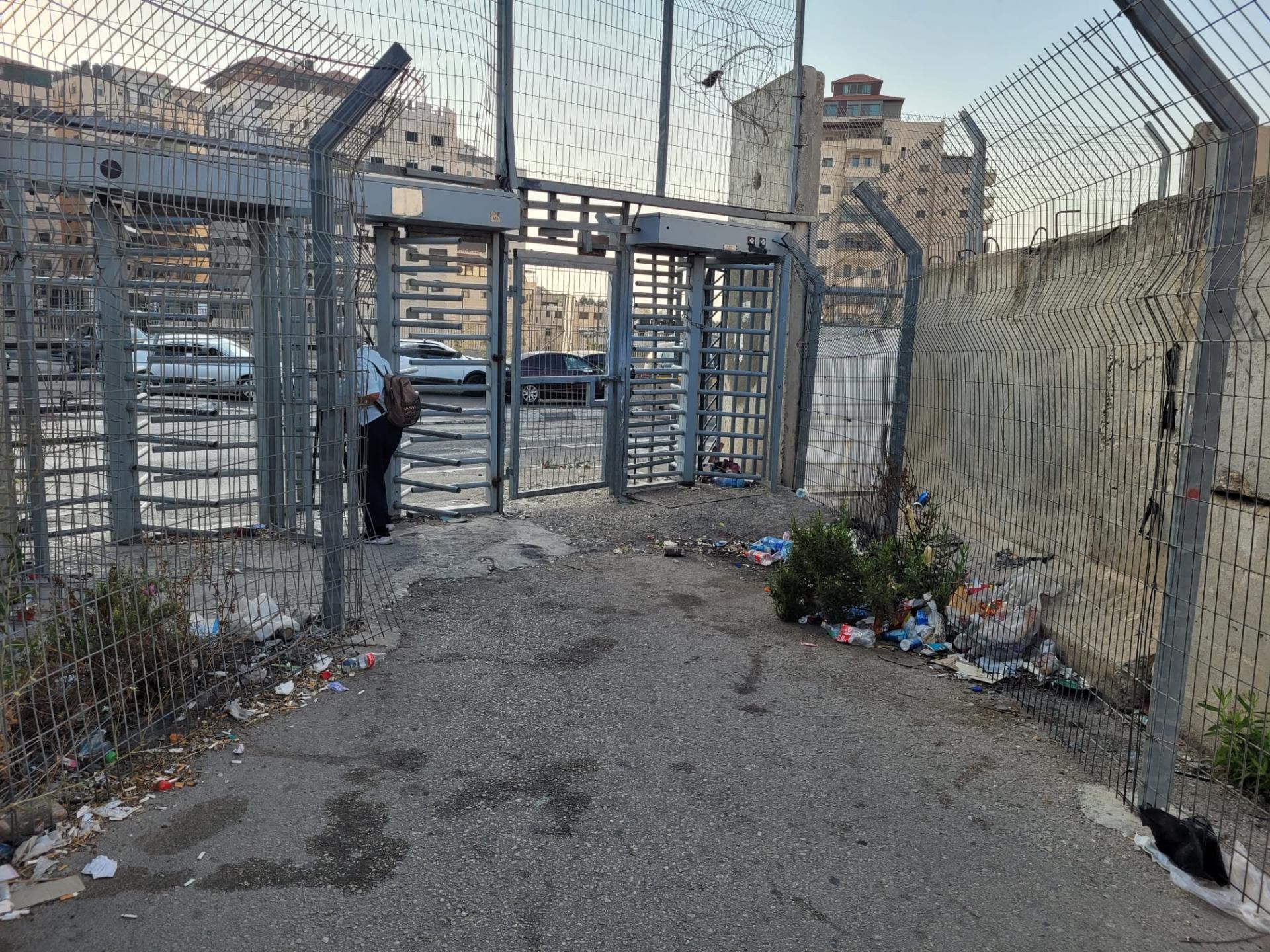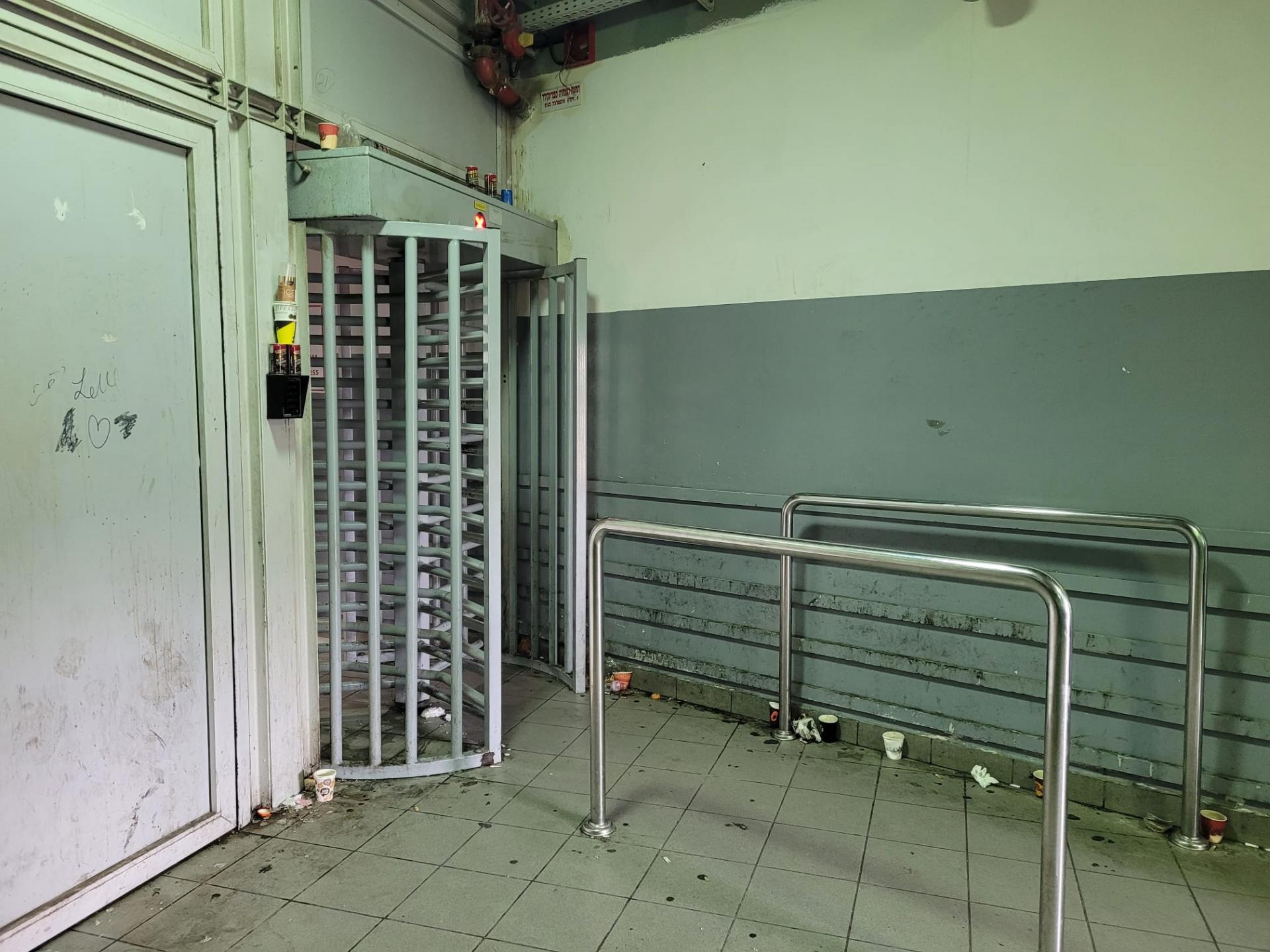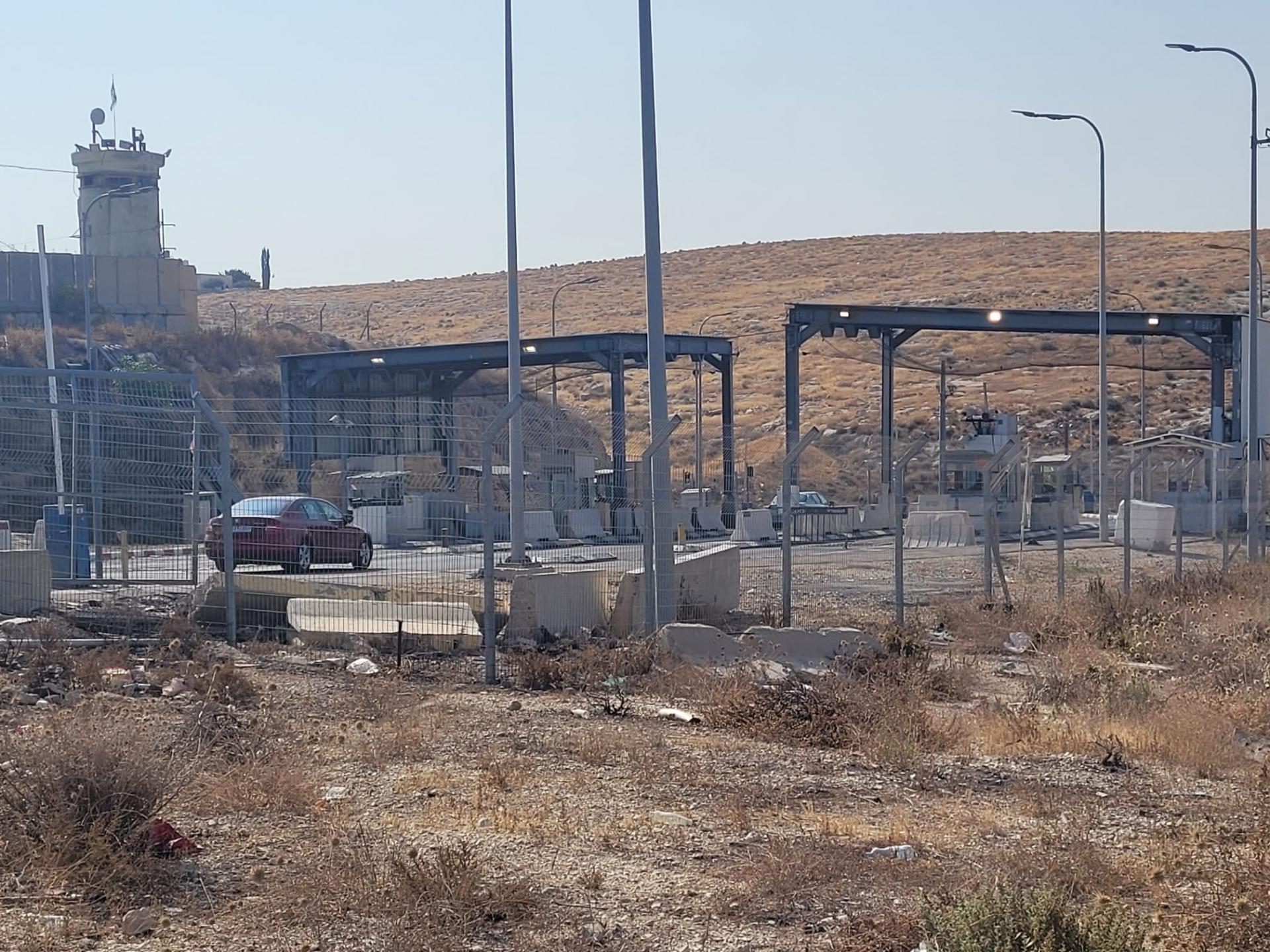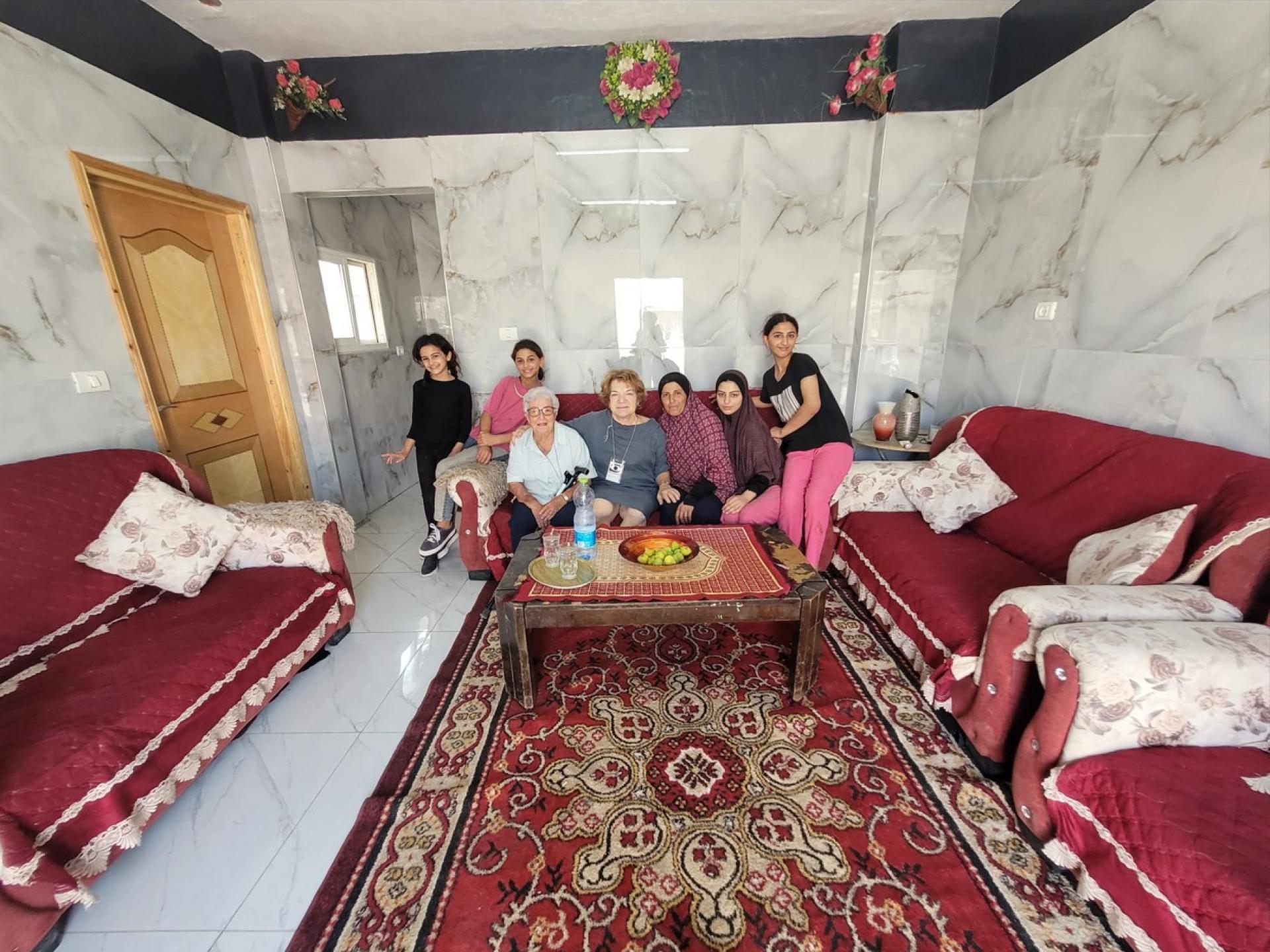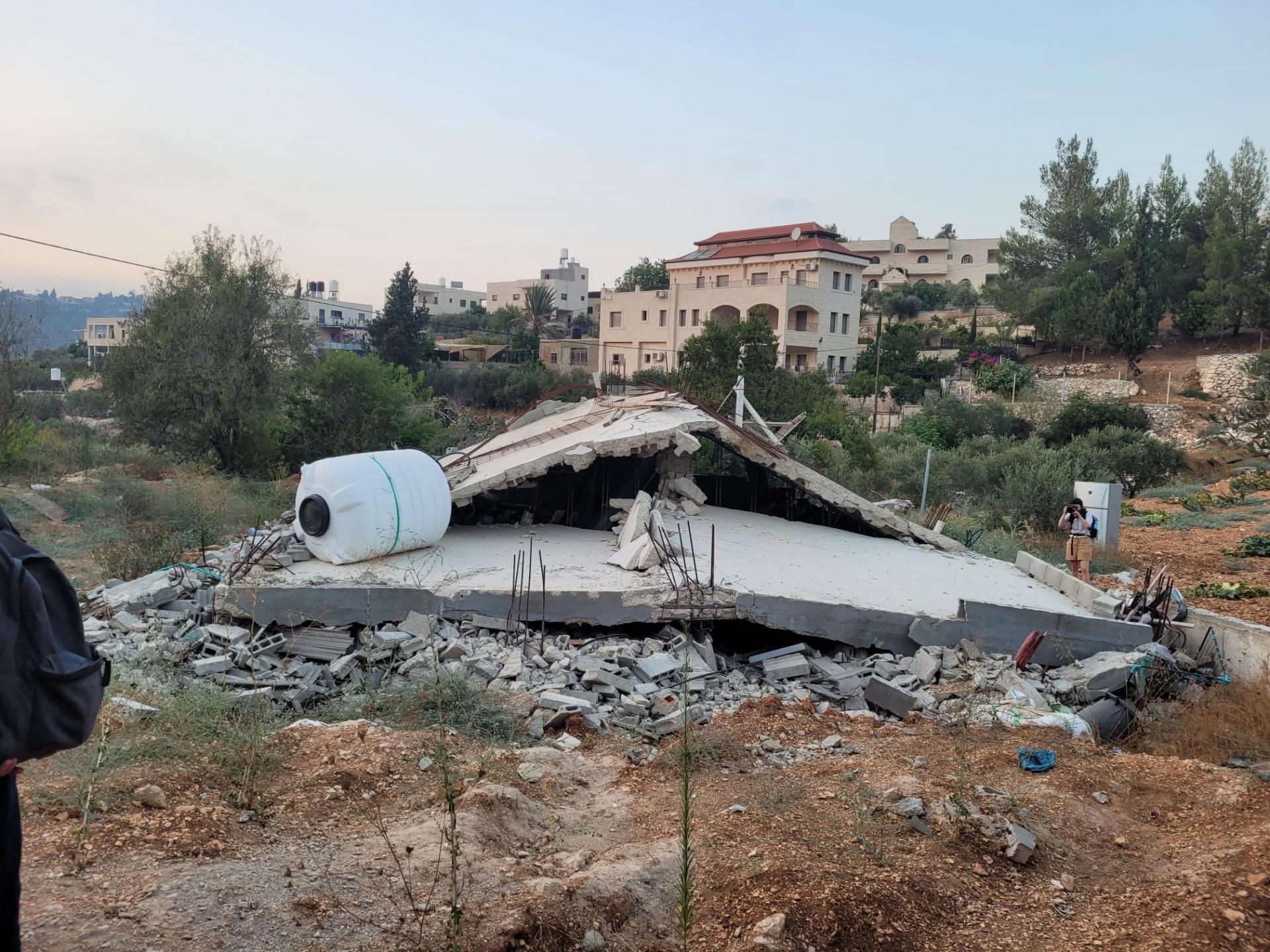Al-Walaja: All these years what did we get from Jerusalem? Only house ruins
07:15 – We entered the long road to Shoafat refugee camp on foot. The road was definitely not planned to be convenient for people entering and leaving. There were traffic jams from the exit of the camp to the checkpoint despite the fact that there are two exit lanes. As usual there were two inspectors from the border patrol and police who were standing in pairs. The children were still on vacation and the parking lot was empty.
We passed through the pedestrian checkpoint. There was garbage and the gate for handicapped persons was locked. It was also blocked by a concrete barrier further on. The neglect surrounding the checkpoint was evident inside and out. One soldier was visible beyond the armored glass of the checkpoint. The speaker that connects the inspector to the people being checked was not operating – a situation that exists at many checkpoints. It is therefore impossible to converse, explain, or ask anything.
The inspection room was dark and dirty. A bucket and board were standing next to the magnetic inspection point. I decided to photograph the area and the cameras spotted me.
An emergency situation began.” The soldier threatened me with arrest and a fine of 1,000 NIs. “It is forbidden to take pictures here!” and closed the turnstiles. I attempted to explain that this is a public crossing and therefore was supposed to be visible to everyone and that human rights organizations had the right to photograph it. A phone consultation with the commander ended with the listing of my I.D. number. It looked like I was added to Ben Gvir’s blacklist. We will see what the repercussions will be… By the way, the photos from my phone appear blurred. Is it possible to hack the program, or are we seeing the beginnings of the bleak future?
We continued and climbed the poor roads to the Ras Al Hamis neighborhood at the top of the hill in the refugee camp. This is part of the Jerusalem municipality and the residents hold Israeli I.D. cards. When the separation barrier was built in 2006 the checkpoint was blocked by a steel gate and people can now only enter and exit through the main checkpoint. Since then crowded buildings with several stories have been built without any examination of the infrastructures or permits. Today, as Shaul Arieli expected, Palestinians have come from Aram, Hebron, and the West bank to live there.
At the exit towards Anata and Route 437 to Jericho and Jerusalem (at the turnoff from the apartheid road of Route 4370) the area is being broadened and a large traffic circle is being constructed. Tractors were also working on the road on the way to the settlement of Anatot. Kamal explained that there are traffic jams at this junction in the morning and afternoon when Israelis - mostly settlers are going and returning from work. It is evident that the widening of the road is designed to improve the situation 0 obviously for the settlers.
Wadi Nar (The Container) - The incorrect sigh that reads “Entry to Area A” had been removed from the entrance to Azriyeh and a red sign warning of the danger of entering the Palestinian town has been placed there instead. This possibly stems from Smutrich’s declaration about ignoring areas from Oslo, but at least there is no doubt that the area is part of Area B and under of Israeli security jurisdiction.
At the container checkpoint cars were crossing slowly from the West bank. And there was a line of cars waiting on the steep hill from the direction of Abadiya )the only road available to Palestinians that leads from the south of the West Bank to the north).;
The Outskirts of Al Khadar – Visit to a family that received demolition orders for their home and are waiting for the decision of the Israeli Supreme Court . The father is a cancer patient and the courageous mother have seven children aged 5-16. Demolition orders have not been issued for any of the other homes in the same row. We were pleased to see the renovations that were done within the present structure by the AMOS Organization and Ecumenical volunteers that have greatly improved the family’s standard of living. The house now includes a modern bathroom and shower, a living room, and separate bedrooms for the girls and boys. We are in close contact with them and provide aid together with the foreign organizations. We will fight together against the cruel decision of the regional military commander that aims to destroy the family’s lives, and they have nowhere to go.
During the afternoon we joined a visit to identify with and protest in the village of al Walaja that was organized by friends of the village and “Ir Ammim” (City of the Peoples). We walked along the streets in the village and listened to stories of families whose homes had been demolished in the past few years. We sat with young parents and their small children outside their home that was liable to be demolished within the next few days. We met with a brave divorced woman next to her house that was demolished recently – leaving her with nothing but the destroyed home and an abandoned refrigerator, and finally met with representatives of the residents. They all pleaded with us to notify the Israeli public about the extreme story of Walaja in the hopes that they will join the current movements of protest and support.
The western part of the village lies within the municipality of Jerusalem, but despite this a wall was built around the entire village in 2009 that chokes the village and prevents the residents from freely accessing their agricultural fields that extend all the way to Giloh. As a representative of the Jerusalem neighborhood committee explained: “The only thing we ever received from the Jerusalem Municipality all these years were demolitions”.” סיפר נציג ועד השכונה
The government never prepared an outline plan for the village of Walaja and the residents were consequently forced to build without permits. In 2022 the government finally agreed for the residents to submit up-to-date plan at their expense. The plan is progressing well through cooperation with the planning and building committee, and hoped to receive the necessary permits. However, the government announced that it plans to demolish an additional six houses and the appeal against these demolition orders was rejected. The terror-stricken residents and don’t sleep at night, and the bulldozers are liable to arrive at any moment. At the time of the last demolition they arrived at 04:00 AM.
During the tour itself no one remained apathetic. Representatives from Machsom Watch (Claire, Netanya, and Anat) who were present asked everyone to share the story on every possible platform and to attempt to join the protest activities.

